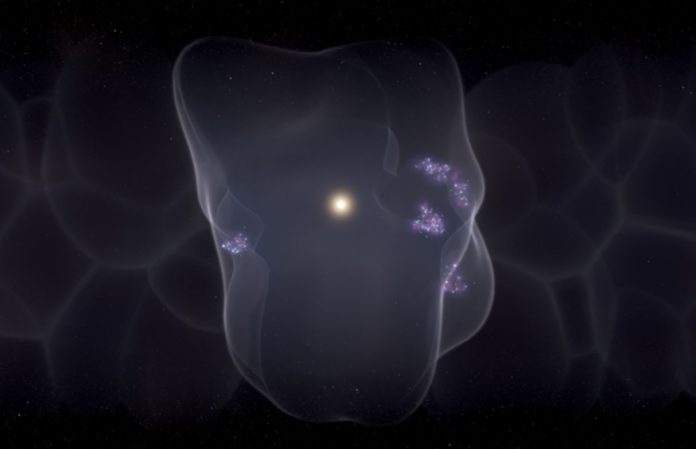The Earth is in a 1,000-light-year-wide gap surrounded by thousands of newborn stars, but how did those stars form?
A new study released today demonstrates how a series of events that began 14 million years ago resulted in the construction of a massive bubble that is responsible for the genesis of all nearby, young stars.
“This is really an origin story; for the first time we can explain how all nearby star formation began,” said astronomer Catherine Zucker.
All newborn stars and star-forming regions within 500 light years of Earth dwell on the surface of a huge bubble known as the Local Bubble, according to the paper’s main figure, a 3D spacetime animation.
While astronomers have known about the Local Bubble for decades, scientists can now see and comprehend how it formed and how it affects the gas surrounding it.
The spacetime animation, created with a treasure of new data and data science approaches, depicts how a chain of supernovae that first exploded 14 million years ago pushed interstellar gas outwards, creating a bubble-like shape with a surface conducive for star formation.
On the bubble’s surface today, seven well-known star-forming regions or molecular clouds — dense regions in space where stars can form — can be found.
“We’ve calculated that about 15 supernovae have gone off over millions of years to form the Local Bubble that we see today,” added Zucker.
According to the astronomers, the strangely formed bubble is not dormant and is slowly growing.
“It’s coasting along at about 4 miles per second,” Zucker added. “It has lost most of its oomph though and has pretty much plateaued in terms of speed.”
Data from ESA Gaia was used to calculate the bubble’s expansion speed as well as the past and present paths of the new stars developing on its surface.
“This is an incredible detective story, driven by both data and theory,” said professor Alyssa Goodman, a study co-author. “We can piece together the history of star formation around us using a wide variety of independent clues: supernova models, stellar motions and exquisite new 3D maps of the material surrounding the Local Bubble.”
“When the first supernovae that created the Local Bubble went off, our Sun was far away from the action” added co-author João Alves. “But about five million years ago, the Sun’s path through the galaxy took it right into the bubble, and now the Sun sits — just by luck — almost right in the bubble’s center.”
Humans today have a front-row seat to the process of star generation occurring all around the bubble’s surface as they stare out into space from near the Sun.
Nearly 50 years ago, astronomers proposed that superbubbles were widespread throughout the Milky Way.
“Now, we have proof — and what are the chances that we are right smack in the middle of one of these things?” questioned Goodman.
She says that if gigantic bubbles are rare in our Milky Way Galaxy, it is statistically implausible that the Sun would be centered in one.
Goodman compares the discovery to a Milky Way that looks like a holey swiss cheese, with holes blasted out by supernovae and new stars forming in the cheese around the holes left by dying stars.
Next, the team plans to map out more intergalactic bubbles, including co-author and Harvard PhD student Michael Foley, to gain a full 3D depiction of their locations, shapes, and sizes. Identifying bubbles and their relationships will help astronomers better understand the role of dead stars in the creation of new stars, as well as the structure and evolution of galaxies like the Milky Way.
Source: 10.1038/s41586-021-04286-5
Image Credit: Leah Hustak (STScI)
You were reading: Study reveals genesis of all nearby, young stars wide bubble surrounding Earth
